Environmental impact of agriculture
The environmental impact of agriculture is the effect that different farming practices have on the ecosystems around them, and how those effects can be traced back to those practices. The environmental impact of agriculture varies widely based on practices employed by farmers and by the scale of practice. Farming communities that try to reduce environmental impacts through modifying their practices will adopt sustainable agriculture practices. The negative impact of agriculture is an old issue that remains a concern even as experts design innovative means to reduce destruction and enhance eco-efficiency. Though some pastoralism is environmentally positive, modern animal agriculture practices tend to be more environmentally destructive than agricultural practices focused on fruits, vegetables and other biomass. The emissions of ammonia from cattle waste continue to raise concerns over environmental pollution.
When evaluating environmental impact, experts use two types of indicators: "means-based", which is based on the farmer's production methods, and "effect-based", which is the impact that farming methods have on the farming system or on emissions to the environment. An example of a means-based indicator would be the quality of groundwater, which is affected by the amount of nitrogen applied to the soil. An indicator reflecting the loss of nitrate to groundwater would be effect-based. The means-based evaluation looks at farmers' practices of agriculture, and the effect-based evaluation considers the actual effects of the agricultural system. For example, the means-based analysis might look at pesticides and fertilization methods that farmers are using, and effect-based analysis would consider how much CO2 is being emitted or what the nitrogen content of the soil is.
The environmental impact of agriculture involves impacts on a variety of different factors: the soil, water, the air, animal and soil variety, people, plants, and the food itself. Agriculture contributes to a number larger of environmental issues that cause environmental degradation including: climate change, deforestation, biodiversity loss, dead zones, genetic engineering, irrigation problems, pollutants, soil degradation, and waste. Because of agriculture's importance to global social and environmental systems, the international community has committed to increasing sustainability of food production as part of Sustainable Development Goal 2: “End hunger, achieve food security and improved nutrition and promote sustainable agriculture". The United Nations Environment Programme's 2021 "Making Peace with Nature" report highlighted agriculture as both a driver and an industry under threat from environmental degradation.
By agricultural practice
Animal agriculture
The environmental impacts of animal agriculture vary because of the wide variety of agricultural practices employed around the world. Despite this, all agricultural practices have been found to have a variety of effects on the environment to some extent. Animal agriculture, in particular meat production, can cause pollution, greenhouse gas emissions, biodiversity loss, disease, and significant consumption of land, food, and water. Meat is obtained through a variety of methods, including organic farming, free-range farming, intensive livestock production, and subsistence agriculture. The livestock sector also includes wool, egg and dairy production, the livestock used for tillage, and fish farming.
Animal agriculture is a significant contributor to greenhouse gas emissions. Cows, sheep, and other ruminants digest their food by enteric fermentation, and their burps are the main source of methane emissions from land use, land-use change, and forestry. Together with methane and nitrous oxide from manure, this makes livestock the main source of greenhouse gas emissions from agriculture. A significant reduction in meat consumption is essential to mitigate climate change, especially as the human population increases by a projected 2.3 billion by the middle of the century.Irrigation
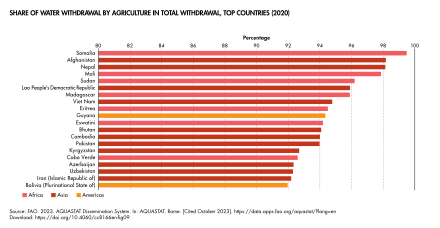

The environmental effects of irrigation relate to the changes in quantity and quality of soil and water as a result of irrigation and the subsequent effects on natural and social conditions in river basins and downstream of an irrigation scheme. The effects stem from the altered hydrological conditions caused by the installation and operation of the irrigation scheme.
Amongst some of these problems is depletion of underground aquifers through overdrafting. Soil can be over-irrigated due to poor distribution uniformity or management wastes water, chemicals, and may lead to water pollution. Over-irrigation can cause deep drainage from rising water tables that can lead to problems of irrigation salinity requiring watertable control by some form of subsurface land drainage. However, if the soil is under irrigated, it gives poor soil salinity control which leads to increased soil salinity with the consequent buildup of toxic salts on the soil surface in areas with high evaporation. This requires either leaching to remove these salts and a method of drainage to carry the salts away. Irrigation with saline or high-sodium water may damage soil structure owing to the formation of alkaline soil.Pesticides
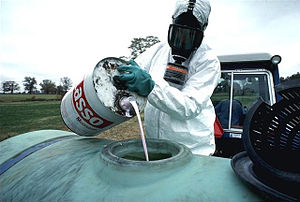
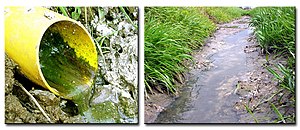

The environmental effects of pesticides describe the broad series of consequences of using pesticides. The unintended consequences of pesticides is one of the main drivers of the negative impact of modern industrial agriculture on the environment. Pesticides, because they are toxic chemicals meant to kill pest species, can affect non-target species, such as plants, animals and humans. Over 98% of sprayed insecticides and 95% of herbicides reach a destination other than their target species, because they are sprayed or spread across entire agricultural fields. Other agrochemicals, such as fertilizers, can also have negative effects on the environment.
The negative effects of pesticides are not just in the area of application. Runoff and pesticide drift can carry pesticides into distant aquatic environments or other fields, grazing areas, human settlements and undeveloped areas. Other problems emerge from poor production, transport, storage and disposal practices. Over time, repeat application of pesticides increases pest resistance, while its effects on other species can facilitate the pest's resurgence. Alternatives to heavy use of pesticides, such as integrated pest management, and sustainable agriculture techniques such as polyculture mitigate these consequences, without the harmful toxic chemical application.
Environmental modelling indicates that globally over 60% of global agricultural land (~24.5 million km²) is "at risk of pesticide pollution by more than one active ingredient", and that over 30% is at "high risk" of which a third are in high-biodiversity regions. Each pesticide or pesticide class comes with a specific set of environmental concerns. Such undesirable effects have led many pesticides to be banned, while regulations have limited and/or reduced the use of others. The global spread of pesticide use, including the use of older/obsolete pesticides that have been banned in some jurisdictions, has increased overall.Plastics

Plasticulture is the practice of using plastic materials in agricultural applications. The plastic materials themselves are often and broadly referred to as "ag plastics". Plasticulture ag plastics include soil fumigation film, irrigation drip tape/tubing, plastic plant packaging cord, nursery pots and bales, but the term is most often used to describe all kinds of plastic plant/soil coverings. Such coverings range from plastic mulch film, row coverings, high and low tunnels (polytunnels), to plastic greenhouses.
Plastic used in agriculture was expected to include 6.7 million tons of plastic in 2019 or 2% of global plastic production. Plastic used in agriculture is hard to recycle because of contamination by agricultural chemicals. Moreover, plastic degradation into microplastics is damaging to soil health, microorganisms and beneficial organisms like earthworms. Current science is not clear if there are negative impacts on food or once food grown in plasticulture is eaten by humans. Because of these impacts, some governments, like the European Union under the Circular Economy Action Plan, are beginning to regulate its use and plastic waste produced on farms.By environmental issue
| External videos | |
|---|---|
|
|
Climate change
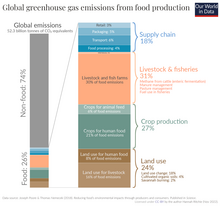
The amount of greenhouse gas emissions from agriculture is significant: The agriculture, forestry and land use sector contribute between 13% and 21% of global greenhouse gas emissions. Agriculture contributes towards climate change through direct greenhouse gas emissions and by the conversion of non-agricultural land such as forests into agricultural land. Emissions of nitrous oxide and methane make up over half of total greenhouse gas emission from agriculture. Animal husbandry is a major source of greenhouse gas emissions.
The agricultural food system is responsible for a significant amount of greenhouse gas emissions. In addition to being a significant user of land and consumer of fossil fuel, agriculture contributes directly to greenhouse gas emissions through practices such as rice production and the raising of livestock. The three main causes of the increase in greenhouse gases observed over the past 250 years have been fossil fuels, land use, and agriculture. Farm animal digestive systems can be put into two categories: monogastric and ruminant. Ruminant cattle for beef and dairy rank high in greenhouse-gas emissions; monogastric, or pigs and poultry-related foods, are low. The consumption of the monogastric types may yield less emissions. Monogastric animals have a higher feed-conversion efficiency, and also do not produce as much methane. Furthermore, CO2 is actually re-emitted into the atmosphere by plant and soil respiration in the later stages of crop growth, causing more greenhouse gas emissions. The amount of greenhouse gases produced during the manufacture and use of nitrogen fertilizer is estimated as around 5% of anthropogenic greenhouse gas emissions. The single most important way to cut emissions from it is to use less fertilizers, while increasing the efficiency of their use.
There are many strategies that can be used to help soften the effects, and the further production of greenhouse gas emissions - this is also referred to as climate-smart agriculture. Some of these strategies include a higher efficiency in livestock farming, which includes management, as well as technology; a more effective process of managing manure; a lower dependence upon fossil-fuels and nonrenewable resources; a variation in the animals' eating and drinking duration, time and location; and a cutback in both the production and consumption of animal-sourced foods. A range of policies may reduce greenhouse gas emissions from the agriculture sector for a more sustainable food system.Deforestation
Deforestation is clearing the Earth's forests on a large scale worldwide and resulting in many land damages. One of the causes of deforestation is clearing land for pasture or crops. According to British environmentalist Norman Myers, 5% of deforestation is due to cattle ranching, 19% due to over-heavy logging, 22% due to the growing sector of palm oil plantations, and 54% due to slash-and-burn farming.
Deforestation causes the loss of habitat for millions of species, and is also a driver of climate change. Trees act as a carbon sink: that is, they absorb carbon dioxide, an unwanted greenhouse gas, out of the atmosphere. Removing trees releases carbon dioxide into the atmosphere and leaves behind fewer trees to absorb the increasing amount of carbon dioxide in the air. In this way, deforestation exacerbates climate change. When trees are removed from forests, the soils tend to dry out because there is no longer shade, and there are not enough trees to assist in the water cycle by returning water vapor back to the environment. With no trees, landscapes that were once forests can potentially become barren deserts. The tree's roots also help to hold the soil together, so when they are removed, mudslides can also occur. The removal of trees also causes extreme fluctuations in temperature.
In 2000 the United Nations Food and Agriculture Organisation (FAO) found that "the role of population dynamics in a local setting may vary from decisive to negligible," and that deforestation can result from "a combination of population pressure and stagnating economic, social and technological conditions."
Genetic engineering
Pollutants

Agricultural pollution refers to biotic and abiotic byproducts of farming practices that result in contamination or degradation of the environment and surrounding ecosystems, and/or cause injury to humans and their economic interests. The pollution may come from a variety of sources, ranging from point source water pollution (from a single discharge point) to more diffuse, landscape-level causes, also known as non-point source pollution and air pollution. Once in the environment these pollutants can have both direct effects in surrounding ecosystems, i.e. killing local wildlife or contaminating drinking water, and downstream effects such as dead zones caused by agricultural runoff is concentrated in large water bodies.
Management practices, or ignorance of them, play a crucial role in the amount and impact of these pollutants. Management techniques range from animal management and housing to the spread of pesticides and fertilizers in global agricultural practices, which can have major environmental impacts. Bad management practices include poorly managed animal feeding operations, overgrazing, plowing, fertilizer, and improper, excessive, or badly timed use of pesticides.
Pollutants from agriculture greatly affect water quality and can be found in lakes, rivers, wetlands, estuaries, and groundwater. Pollutants from farming include sediments, nutrients, pathogens, pesticides, metals, and salts. Animal agriculture has an outsized impact on pollutants that enter the environment. Bacteria and pathogens in manure can make their way into streams and groundwater if grazing, storing manure in lagoons and applying manure to fields is not properly managed. Air pollution caused by agriculture through land use changes and animal agriculture practices have an outsized impact on climate change, and addressing these concerns was a central part of the IPCC Special Report on Climate Change and Land. Mitigation of agricultural pollution is a key component in the development of a sustainable food system.Soil degradation

Soil degradation is the decline in soil quality that can be a result of many factors, especially from agriculture. Soils hold the majority of the world's biodiversity, and healthy soils are essential for food production and adequate water supply. Common attributes of soil degradation can be salting, waterlogging, compaction, pesticide contamination, a decline in soil structure quality, loss of fertility, changes in soil acidity, alkalinity, salinity, and erosion. Soil erosion is the wearing away of topsoil by water, wind, or farming activities. Topsoil is very fertile, which makes it valuable to farmers growing crops. Soil degradation also has a huge impact on biological degradation, which affects the microbial community of the soil and can alter nutrient cycling, pest and disease control, and chemical transformation properties of the soil.
Soil erosion
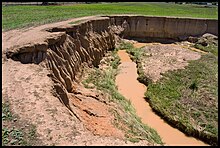
Large scale farming can cause large amounts of soil erosion. 25 to 40 percent of eroded soil ends up in water sources. Soil that carries pesticides and fertilizers pollutes the bodies of water it enters. In the United States and Europe especially, large-scale agriculture has grown and small-scale-agriculture has shrunk due to financial arrangements such as contract farming. Bigger farms tend to favour monocultures, overuse water resources, and accelerate deforestation and soil quality decline. A study from 2020 by the International Land Coalition, together with Oxfam and World Inequality Lab, found that 1% of land owners manage 70% of the world's farmland. The highest discrepancy can be found in Latin America, where the poorest 50% own just 1% of the land. Small landowners, as individuals or families, tend to be more cautious in land use compared to large landowners. As of 2020, however, the proportion of small landowners has been decreasing since the 1980s. Currently, the largest share of smallholdings can be found in Asia and Africa.
Tillage erosion

Tillage erosion is a form of soil erosion occurring in cultivated fields due to the movement of soil by tillage. There is growing evidence that tillage erosion is a major soil erosion process in agricultural lands, surpassing water and wind erosion in many fields all around the world, especially on sloping and hilly lands A signature spatial pattern of soil erosion shown in many water erosion handbooks and pamphlets, the eroded hilltops, is actually caused by tillage erosion as water erosion mainly causes soil losses in the midslope and lowerslope segments of a slope, not the hilltops. Tillage erosion results in soil degradation, which can lead to significant reduction in crop yield and, therefore, economic losses for the farm.

Waste
Plasticulture is the use of plastic mulch in agriculture. Farmers use plastic sheets as mulch to cover 50-70% of the soil and allow them to use drip irrigation systems to have better control over soil nutrients and moisture. Rain is not required in this system, and farms that use plasticulture are built to encourage the fastest runoff of rain. The use of pesticides with plasticulture allows pesticides to be transported easier in the surface runoff towards wetlands or tidal creeks. The runoff from pesticides and chemicals in the plastic can cause serious deformations and death in shellfish as the runoff carries the chemicals toward the oceans.
In addition to the increased runoff that results from plasticulture, there is also the problem of the increased amount of waste from the plastic mulch itself. The use of plastic mulch for vegetables, strawberries, and other row and orchard crops exceeds 110 million pounds annually in the United States. Most plastic ends up in the landfill, although there are other disposal options such as disking mulches into the soil, on-site burying, on-site storage, reuse, recycling, and incineration. The incineration and recycling options are complicated by the variety of the types of plastics that are used and by the geographic dispersal of the plastics. Plastics also contain stabilizers and dyes as well as heavy metals, which limits the number of products that can be recycled. Research is continually being conducted on creating biodegradable or photodegradable mulches. While there has been a minor success with this, there is also the problem of how long the plastic takes to degrade, as many biodegradable products take a long time to break down.
Issues by region
The environmental impact of agriculture can vary depending on the region as well as the type of agriculture production method that is being used. Listed below are some specific environmental issues in various different regions around the world.
- Hedgerow removal in the United Kingdom.
- Soil salinisation, especially in Australia.
- Phosphate mining in Nauru
- Methane emissions from livestock in New Zealand. See Climate change in New Zealand.
- Environmentalists attribute the hypoxic zone in the Gulf of Mexico as being encouraged by nitrogen fertilization of the algae bloom.
- Coupled systems from agricultural trade leading to regional effects from cascading effects and spillover systems. Environmental factor (Socioeconomic Drivers Section)
Sustainable agriculture
Sustainable agriculture is the idea that agriculture should occur in a way such that we can continue to produce what is necessary without infringing on the ability for future generations to do the same.
The exponential population increase in recent decades has increased the practice of agricultural land conversion to meet the demand for food which in turn has increased the effects on the environment. The global population is still increasing and will eventually stabilize, as some critics doubt that food production, due to lower yields from global warming, can support the global population.
Agriculture can have negative effects on biodiversity as well. Organic farming is a multifaceted sustainable agriculture set of practices that can have a lower impact on the environment at a small scale. However, in most cases organic farming results in lower yields in terms of production per unit area. Therefore, widespread adoption of organic agriculture will require additional land to be cleared and water resources extracted to meet the same level of production. A European meta-analysis found that organic farms tended to have higher soil organic matter content and lower nutrient losses (nitrogen leaching, nitrous oxide emissions, and ammonia emissions) per unit of field area but higher ammonia emissions, nitrogen leaching and nitrous oxide emissions per product unit. It is believed by many that conventional farming systems cause less rich biodiversity than organic systems. Organic farming has shown to have on average 30% higher species richness than conventional farming. Organic systems on average also have 50% more organisms. This data has some issues because there were several results that showed a negative effect on these things when in an organic farming system. The opposition to organic agriculture believes that these negatives are an issue with the organic farming system. What began as a small scale, environmentally conscious practice has now become just as industrialized as conventional agriculture. This industrialization can lead to the issues shown above such as climate change, and deforestation.
Regenerative agriculture
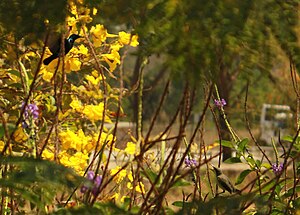
Regenerative agriculture is a conservation and rehabilitation approach to food and farming systems. It focuses on topsoil regeneration, increasing biodiversity, improving the water cycle, enhancing ecosystem services, supporting biosequestration, increasing resilience to climate change, and strengthening the health and vitality of farm soil.
Regenerative agriculture is not a specific practice itself. Rather, proponents of regenerative agriculture use a variety of sustainable agriculture techniques in combination. Practices include recycling as much farm waste as possible and adding composted material from sources outside the farm. Regenerative agriculture on small farms and gardens is often based on philosophies like permaculture, agroecology, agroforestry, restoration ecology, keyline design, and holistic management. Large farms are also increasingly adopting regenerative techniques and often use "no-till" and/or "reduced till" practices.
As soil health improves, input requirements may decrease, and crop yields may increase as soils are more resilient against extreme weather and harbor fewer pests and pathogens.
Regenerative agriculture mitigates climate change through carbon dioxide removal, i.e. it draws carbon from the atmosphere and sequesters it. Along with decreasing carbon emissions, carbon sequestration practices are gaining popularity in agriculture, and individuals and groups are taking action to fight climate change.
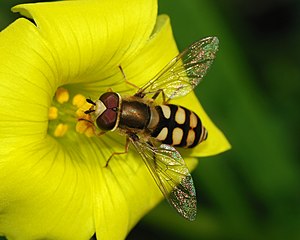
Techniques
Conservation tillage
Conservation tillage is an alternative tillage method for farming which is more sustainable for the soil and surrounding ecosystem. This is done by allowing the residue of the previous harvest's crops to remain in the soil before tilling for the next crop. Conservation tillage has shown to improve many things such as soil moisture retention, and reduce erosion. Some disadvantages are the fact that more expensive equipment is needed for this process, more pesticides will need to be used, and the positive effects take a long time to be visible. The barriers of instantiating a conservation tillage policy are that farmers are reluctant to change their methods, and would protest a more expensive, and time-consuming method of tillage than the conventional one they are used to.
Biological pest control
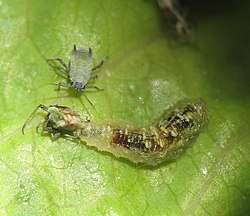
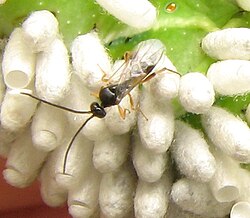
Biological control or biocontrol is a method of controlling pests, whether pest animals such as insects and mites, weeds, or pathogens affecting animals or plants by using other organisms. It relies on predation, parasitism, herbivory, or other natural mechanisms, but typically also involves an active human management role. It can be an important component of integrated pest management (IPM) programs.
There are three basic strategies for biological control: classical (importation), where a natural enemy of a pest is introduced in the hope of achieving control; inductive (augmentation), in which a large population of natural enemies are administered for quick pest control; and inoculative (conservation), in which measures are taken to maintain natural enemies through regular reestablishment.
Natural enemies of insects play an important part in limiting the densities of potential pests. Biological control agents such as these include predators, parasitoids, pathogens, and competitors. Biological control agents of plant diseases are most often referred to as antagonists. Biological control agents of weeds include seed predators, herbivores, and plant pathogens.
Biological control can have side-effects on biodiversity through attacks on non-target species by any of the above mechanisms, especially when a species is introduced without a thorough understanding of the possible consequences.See also
- Agroecology
- Agricultural pollution
- Agro-hydro-salinity model (for environmental impacts of irrigated agriculture)
- Cultured meat
- Digital Product Passport
- Ethical eating
- Fermentation
- Meat analogue
- Environmental effects of soybean imports to EU
- Single cell protein
- Stranded assets in the agriculture and forestry sector
- Concentrated animal feeding operations
- List of environmental issues
- Habitat
- Holistic management
- Livestock's Long Shadow – Environmental Issues and Options
- Report by the Food and Agriculture Organization of the United Nations